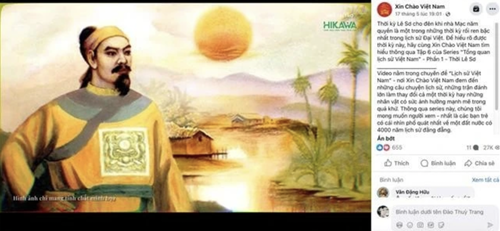Known online as "Tuyet Mai Lay Di," Nguyen Thi Tuyet Mai, 24, is one of the standout content creators in spreading traditional culture. She currently has nearly 800,000 followers and 24 million likes on TikTok alone. Her videos present historical stories and figures in an accessible and creative way, helping young audiences love and understand Vietnamese culture from a fresh perspective. In particular, the traditional Vietnamese outfits she recreates have captured the interest of Gen Z and fashion enthusiasts alike.
    |
 |
|
Video introducing the history by Long Khoa Hoc (Screenshot: thanhnien.vn) |
Famous for his digital content on tech products and scientific explanations, Long Khoa Hoc, 29, has recently expanded into culture, history, and traditional arts through channels like Xin Chao Viet Nam (Hello Vietnam) and Hanh trinh di san (Heritage Journey). Through these platforms, Long and his team aim to tell stories about Vietnamese culture, cuisine, and people using modern digital language, igniting patriotism and preserving traditional values among young people.
His team has already “adapted” numerous topics, data, historical figures, legends, literary works, theatrical arts, folklore, and festivals into short videos with a youthful and humorous style, attracting millions of likes and followers across digital platforms. Similarly, many other young creators are engaging in unique "remix" forms of cultural content — from livestreaming as folk characters to producing fictional historical character interviews in podcast format.
Capturing the attention of young audiences is no longer just a trend, it's a strategic move to build a loyal viewership community for the future. Cultural and performing arts institutions cannot stand on the sidelines.
Meritorious Artist Nguyen Hai Linh, Director of the Vietnam National Music Song and Dance Theatre, said that despite still in the early stages, the theatre has already started digitizing its art programs to archive and promote them on YouTube and its website.
    |
 |
|
Heritage is no longer something to simply "display," but has become a material for modern creativity and generational connection. (Photo: thanhnien.vn) |
According to Linh, in the coming time, the theater will intensify digitisation and communication on platforms such as TikTok and other social media channels where young audiences are highly active. He emphasised that the key lies in researching and closely following the preferences of young viewers, thereby producing suitable content, presentation formats, and production models. The theatre has also prepared a dedicated team of young staff to effectively carry out this initiative.
A positive sign is that more and more young people are revitalizing heritage using their own language: from fashion collections inspired by traditional costumes on Instagram, vlogs exploring craft villages, memes telling folk tales, to reaction videos on traditional festivals. What was once seen as "breaking the rules" has now become an effective bridge between tradition and the younger audience revitalizing.
Digitization has helped young people shift from a passive role of reception to actively exploring, discovering, and reflecting. Heritage is no longer something to simply "display," but has become a material for modern creativity and generational connection. AI technology is also being applied in recreating ancient singing voices and restoring pronunciation and lost tones for example, thereby creating cultural experiences that engage the auditory, visual, and emotional senses.
Dang Thi Phuong Thao, Deputy Director of the Authority of Press, stated that to spread culture to the young generation, it is necessary to have quality products that are ‘packaged’ with the right aesthetics and language for them.
Digitization does not mean commercialization or oversimplification of culture. It is a way of selecting, adapting, and spreading traditional values through a modern language. When tradition is retold in the language of the times, it is no longer something "to be learned," but something "to be heard and shared," Thao stressed.
Source: VNA